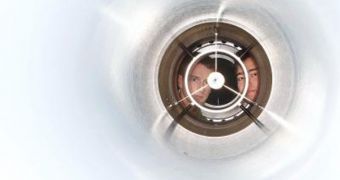Purdue University School of Aeronautics and Astronautics professor Steven Schneider worked together with NASA on installing a new scientific experiment aboard the Discovery space shuttle, as it was launched towards the International Space Station (ISS), on its 13-day mission. Among the thousand of tiles that made up the craft's heat shield, Schneider helped implement a protruding element that was meant to measure temperature patterns across the shield, as well as to detect exactly how air flows changed from smooth (laminar), to turbulent.
“We have been arguing in favor of doing some sort of space shuttle flight experiment, and after the Columbia accident there was a lot more attention paid to aero heating,” the expert said. He mentioned that it was exactly mistakes in these calculations that led to the horrible accident of space shuttle Colombia, which disintegrated on reentry in 2003. Engineers believe that one or more pieces of the shield became overheated and gave way, which caused a chain reaction that destroyed the entire craft.
The data that will be gathered as Discovery reenters Earth's atmosphere will have numerous applications in various fields, but especially in aeronautics and airplane building. Constructors around the world will use the knowledge accumulated by Schneider's device in order to create airplanes covered in materials that allow them to reduce the heat regular metal generates when going faster than Mach 5. In addition, the same data will be used in the construction of NASA's Orion Crew Exploration vehicle, which is to be completed by 2015.
“It is very desirable to conduct an experiment like this under real flight conditions on a real shuttle instead of a model. But no single experiment, whether on the ground or in flight, can give you everything you want,” he shared, saying that the information that would be collected on Saturday was due to be added to computer simulations and model readings, to give scientists at NASA the best possible view of what happened upon reentry.
The same experiment will also be installed on two other space missions, so as to ensure that data are collected in various conditions. Despite the exact flight path the shuttles follow on reentry, no descent is exactly identical to the other ones, and engineers hope to learn a lot from these small differences.

 14 DAY TRIAL //
14 DAY TRIAL //